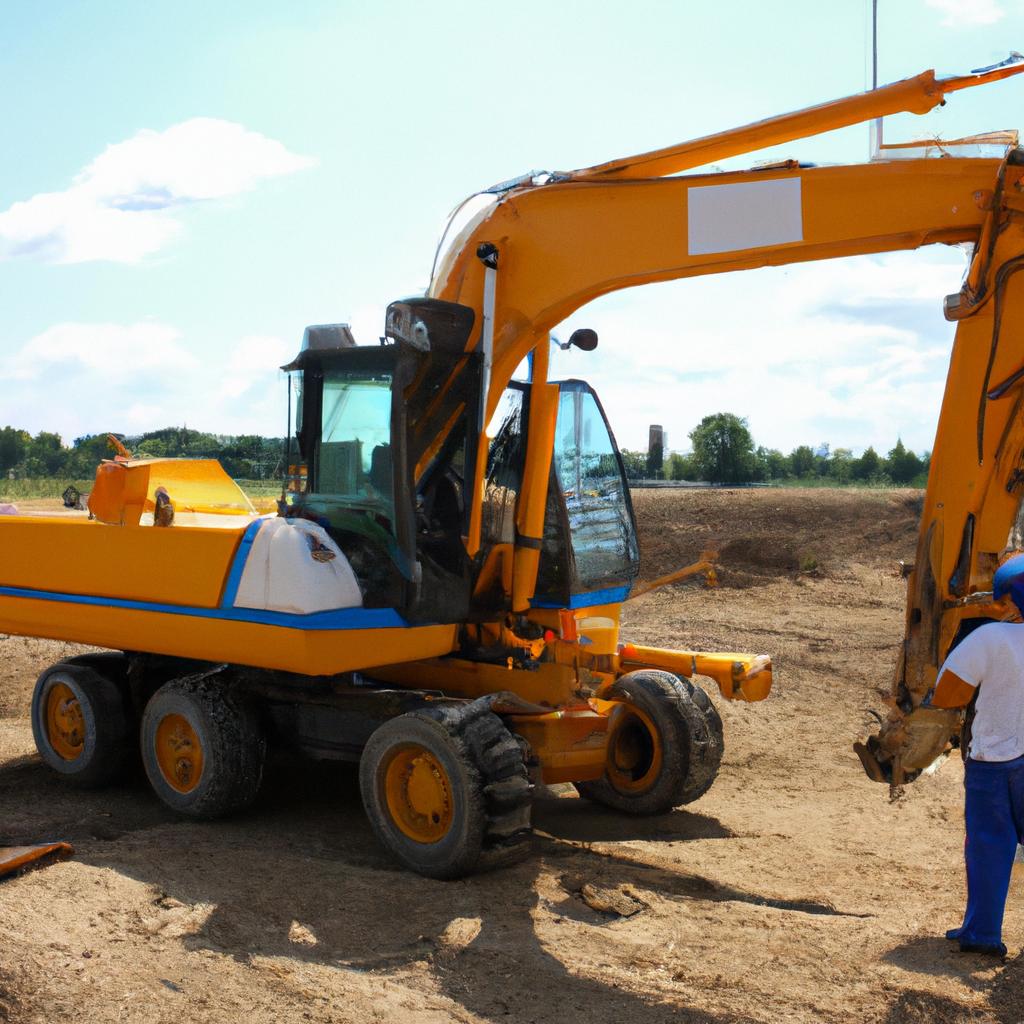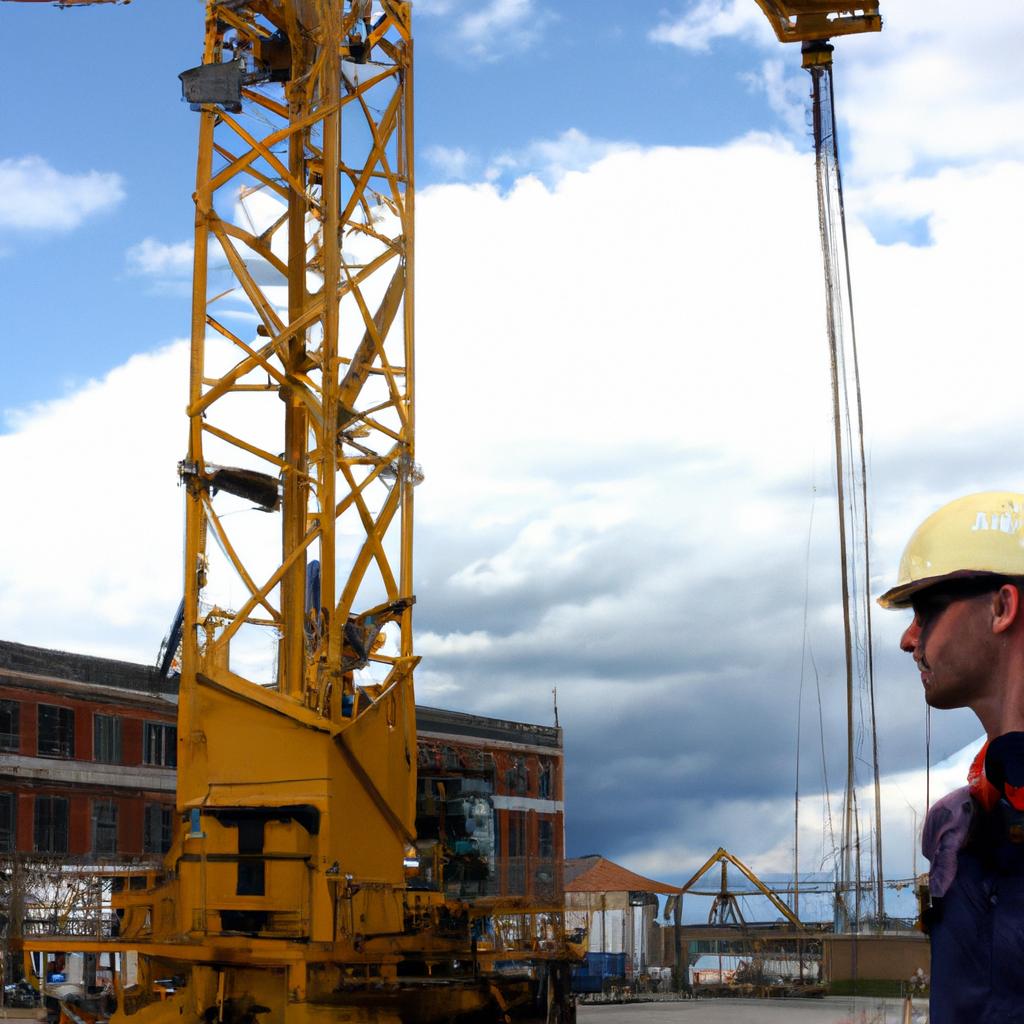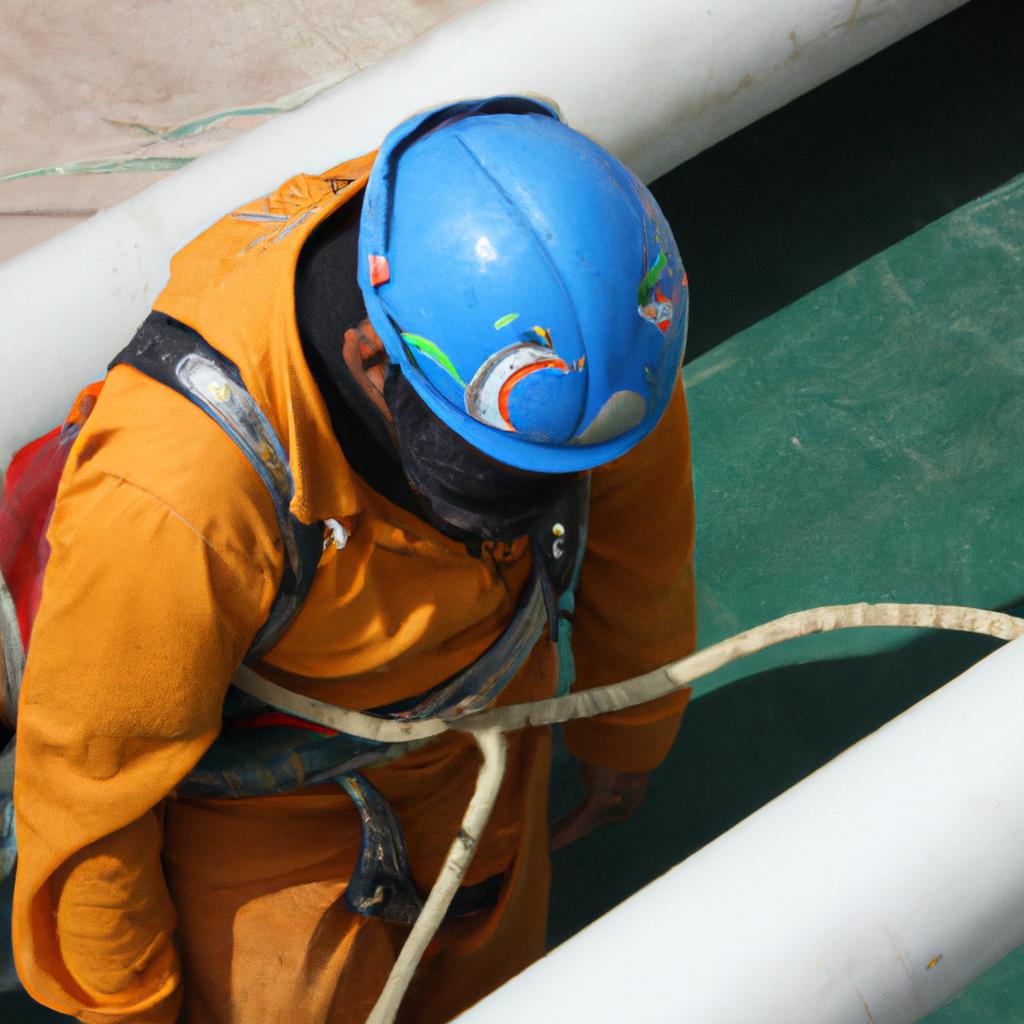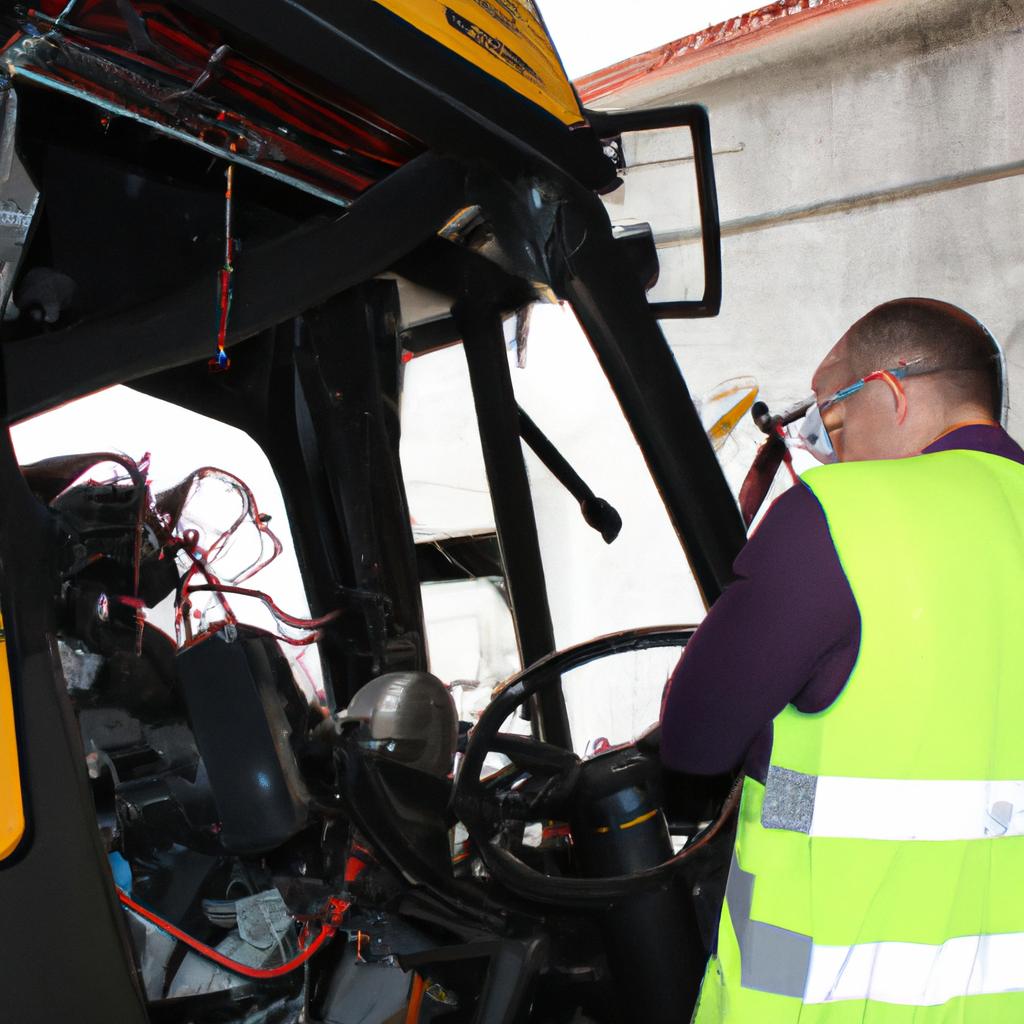Heavy equipment maintenance is a crucial aspect of construction operations, ensuring the reliability and longevity of machinery. Without regular maintenance, heavy equipment can experience significant breakdowns and failures, leading to costly repairs and downtime. For instance, consider a hypothetical scenario where a construction company neglects proper maintenance on their excavator. As a result, the machine experiences engine failure during an important project, causing delays in completion and financial losses for the company.
In order to avoid such detrimental situations, it is essential for construction companies to implement effective maintenance strategies for their heavy equipment. This article aims to provide essential tips and guidelines for conducting efficient maintenance practices on construction equipment. By following these recommendations, companies can minimize unexpected breakdowns and maximize productivity on construction sites.
Importance of regular maintenance
Importance of Regular Maintenance
Regular maintenance is a crucial aspect of heavy equipment management in the construction industry. By adhering to a well-structured maintenance schedule, companies can ensure that their machinery operates at optimal levels and minimize downtime due to unexpected breakdowns. This section will underscore the significance of regular maintenance through an illustrative example, followed by a bullet point list highlighting its benefits.
Case Study Example:
Let us consider a hypothetical scenario where two construction companies, A and B, operate similar fleets of heavy equipment. Company A diligently follows routine maintenance procedures for their machinery, while company B neglects this essential practice. Over time, company A experiences significantly fewer instances of equipment failure compared to company B. Such scenarios exemplify the importance of regular maintenance as it directly impacts productivity and operational efficiency.
Benefits of Regular Maintenance:
Regular maintenance offers several advantages that contribute to smoother operations and long-term cost savings. These include:
- Enhanced Equipment Performance: Consistent upkeep ensures that heavy machinery functions optimally throughout its lifespan.
- Increased Safety Measures: Routine inspections identify potential hazards or faulty components before they lead to accidents or injuries on-site.
- Extended Lifespan: Properly maintained equipment tends to last longer, reducing overall replacement costs.
- Reduced Downtime: Timely repairs and preventive measures decrease unplanned downtimes, allowing projects to progress smoothly according to schedules.
| Benefits of Regular Maintenance |
|---|
| Enhanced Equipment Performance |
| Increased Safety Measures |
| Extended Lifespan |
| Reduced Downtime |
In summary, regular maintenance plays a critical role in maintaining efficient heavy equipment operations within the construction industry. Through diligent adherence to scheduled inspections and necessary repairs, companies can optimize performance while minimizing safety risks and costly delays due to breakdowns. In the subsequent section about “Key components to inspect and maintain,” we will delve into specific aspects that demand attention during routine maintenance processes without losing sight of the overarching goal of operational excellence.
Key components to inspect and maintain
Regular maintenance is crucial for ensuring the optimal performance and longevity of construction equipment. In addition to conducting routine inspections, it is important to focus on key components that play a vital role in the overall functionality of heavy machinery. By giving careful attention to these components, potential issues can be identified early on, preventing costly breakdowns and improving safety on site.
For example, let’s consider a hypothetical scenario where a bulldozer is being used on a construction project. One day, during routine inspection, the operator notices unusual vibrations while operating the machine. Upon further investigation, it is discovered that the track chains are worn out and need immediate replacement. If this issue had gone unnoticed or was not addressed promptly, it could have led to severe damage to other parts of the bulldozer as well as increased downtime.
To avoid such situations, here are some key components that should be regularly inspected and maintained:
- Hydraulic system: Check for leaks or signs of wear in hoses and connectors.
- Electrical system: Inspect wiring harnesses for any damages that may cause electrical failures.
- Cooling system: Clean radiators regularly to prevent overheating.
- Braking system: Ensure proper functioning of brakes by checking brake pads and fluids.
The table below highlights the importance of maintaining these key components:
| Component | Importance | Impact of Neglect |
|---|---|---|
| Hydraulic System | Proper operation and control | Reduced efficiency; Potential hydraulic failure |
| Electrical System | Ensures smooth functioning | Malfunctioning equipment; Safety hazards |
| Cooling System | Prevents overheating | Engine damage; Increased risk of fire |
| Braking System | Essential for safe operations | Accidents due to failed braking |
By prioritizing regular inspection and maintenance of these critical components, heavy equipment owners can minimize unexpected breakdowns, reduce repair costs, enhance productivity, and most importantly, ensure the safety of operators and workers on construction sites.
Moving forward, it is essential to also focus on proper lubrication techniques for heavy equipment.
Proper lubrication techniques
Having discussed the key components that require regular inspection and maintenance, it is equally important to emphasize proper lubrication techniques. Ensuring adequate lubrication not only prolongs the lifespan of construction equipment but also enhances its overall performance. Let us explore some essential practices in this regard.
Proper Lubrication Techniques:
To illustrate the significance of effective lubrication, consider a hypothetical scenario where an excavator’s bucket cylinder begins to experience excessive friction due to inadequate lubrication. As a result, the machine’s productivity decreases significantly, leading to delays in completing crucial tasks on construction sites.
- Selecting the right lubricant:
- Choosing appropriate lubricants based on manufacturer specifications ensures optimal performance and minimizes potential damage.
- Factors such as temperature variations, load capacity, and operating conditions should be considered when selecting the most suitable lubricant.
- Applying lubricants at recommended intervals:
- Regularly greasing and applying oils according to manufacturer guidelines prevents excessive wear and tear.
- Following suggested maintenance schedules helps maintain consistent functionality while reducing downtime caused by unexpected breakdowns.
- Inspecting seals and fittings:
- Periodically checking seals and fittings for leaks or damages allows early detection of potential issues.
- Promptly replacing faulty parts prevents contamination from entering sensitive areas of machinery, thereby avoiding expensive repairs.
- Implementing proper storage procedures:
- Properly storing unused lubricants away from contaminants safeguards their effectiveness over extended periods.
- Storing products in designated areas with controlled humidity levels maintains their quality until they are ready for use.
The benefits of implementing proper lubrication techniques include:
- Enhanced equipment longevity
- Improved operational efficiency
- Reduced risk of costly repairs
- Increased safety for operators
Importance of Proper Lubrication Techniques:
| Benefits | Description |
|---|---|
| Enhanced equipment longevity | Regular lubrication prevents premature wear and tear. |
| Improved operational efficiency | Properly lubricated components enhance machine performance. |
| Reduced risk of costly repairs | Adequate lubrication minimizes the likelihood of breakdowns. |
| Increased safety for operators | Well-lubricated machinery reduces the risk of accidents due to faulty parts. |
In addition to proper lubrication techniques, another crucial aspect of heavy equipment maintenance is keeping the machinery clean. By implementing effective cleaning practices, construction companies can ensure optimal functionality and extend the lifespan of their equipment.
Please let me know if there’s anything else I can assist you with!
Tips for keeping equipment clean
Section: Best Practices for Heavy Equipment Maintenance
In order to ensure the longevity and optimal performance of construction equipment, it is crucial to implement proper maintenance techniques.
To highlight the importance of cleanliness in maintaining heavy equipment, let us consider a hypothetical scenario where an excavator operating at a construction site encounters frequent breakdowns due to accumulated dirt and debris. The excessive build-up affects its functionality, resulting in decreased productivity and increased repair costs. By regularly cleaning the equipment, these issues can be effectively mitigated.
Here are some key tips for keeping your construction equipment clean:
- Regular washing: Develop a routine schedule for washing your equipment using appropriate detergents and cleaners.
- Thorough inspection: After each wash, conduct a thorough inspection to identify any signs of wear or damage caused by dirt accumulation.
- Component-specific cleaning: Pay special attention to sensitive components such as filters, radiators, hydraulic lines, and electrical connections when cleaning.
- Proper storage: Store cleaned equipment in designated areas away from environmental factors like rain or extreme temperatures.
The following table illustrates the potential consequences associated with neglecting regular cleaning practices:
| Neglected Cleaning | Consequences |
|---|---|
| Accumulation of dirt and debris | Reduced efficiency |
| Corrosion or rust formation | Premature component failure |
| Clogged filters or radiator fins | Overheating issues |
| Electrical system malfunctions | Safety hazards |
By adhering to these best practices outlined above, you can significantly enhance the overall lifespan and reliability of your heavy machinery. In addition to proper lubrication techniques covered previously, implementing effective maintenance strategies ultimately translates into greater operational effectiveness and cost savings.
Transitioning seamlessly into our next topic about “Effective troubleshooting methods,” we’ll explore how to identify and resolve issues that may arise during the operation of construction equipment. Understanding these troubleshooting techniques is crucial for minimizing downtime and maximizing productivity on construction sites.
Effective troubleshooting methods
Section H2: Effective Troubleshooting Methods
Imagine you are a construction site manager and one of your heavy equipment suddenly stops functioning. This unexpected breakdown not only brings work to a halt but also leads to costly delays and frustration among the workers. To minimize such situations, it is crucial for construction companies to implement effective troubleshooting methods that can quickly identify and resolve problems with their equipment. In this section, we will explore several techniques that can help in efficiently troubleshooting construction equipment issues.
Troubleshooting Techniques:
-
Diagnostic Checks: Conducting regular diagnostic checks on your heavy equipment can help detect potential problems before they escalate into major failures. These checks involve assessing various components such as engine performance, hydraulic systems, electrical connections, and fuel efficiency. By being proactive in identifying underlying issues through diagnostic checks, you can save both time and money by addressing them promptly.
-
Error Code Analysis: Many modern construction machines come equipped with advanced onboard computers or control panels that display error codes whenever there is an issue. Understanding these error codes provides valuable insights into specific malfunctions or faulty components within the machinery. By referring to the manufacturer’s manual or seeking professional assistance when deciphering error codes, operators can effectively troubleshoot the problem at hand.
-
Collaboration with Technical Experts: Sometimes complex equipment issues require technical expertise beyond what onsite staff possesses. Collaborating with specialized technicians or engineers who have experience working with similar machinery can be instrumental in resolving intricate problems efficiently. These experts possess comprehensive knowledge about the specific model of equipment and often have access to specialized tools necessary for accurate diagnosis.
Emotional Bullet Point List
- Minimize downtime caused by equipment breakdowns
- Reduce repair costs through timely troubleshooting
- Improve overall productivity on construction sites
- Enhance worker morale by preventing unnecessary frustrations
Table (Markdown format):
| Potential Benefits | Construction Equipment Troubleshooting |
|---|---|
| Decreased Downtime | ✔ |
| Lower Repair Costs | ✔ |
| Increased Productivity | ✔ |
| Improved Worker Morale | ✔ |
By implementing effective troubleshooting methods, construction companies can minimize equipment downtime and ensure smooth operations on their sites. However, it is equally important to prioritize safety measures during maintenance to protect both workers and machinery. In the following section, we will discuss essential safety practices that should be followed when performing maintenance tasks on heavy construction equipment.
Safety measures during maintenance
Having discussed effective troubleshooting methods in the previous section, it is crucial to address safety measures that need to be taken during heavy equipment maintenance. By implementing these precautions, construction companies can ensure the well-being of their workers and minimize accidents or injuries.
Safety Measures During Maintenance:
-
Conducting regular inspections:
Regular inspections are vital for identifying potential hazards and ensuring the safe operation of heavy equipment. Inspections should include checking for any loose or worn-out parts, leaks, malfunctioning controls, and damaged safety features. For example, consider a hypothetical scenario where an excavator’s hydraulic system shows signs of leakage during routine maintenance inspection. Promptly addressing this issue by repairing or replacing the faulty component can prevent major breakdowns or hazardous situations. -
Providing comprehensive training:
Proper training on equipment maintenance procedures is essential to mitigate risks associated with heavy machinery. Workers must receive adequate instruction on handling specific machines and following safety protocols while conducting repairs or adjustments. This includes understanding lockout/tagout procedures, which help prevent accidental starts or energy release during servicing tasks. -
Utilizing personal protective equipment (PPE):
Workers involved in heavy equipment maintenance should always wear appropriate PPE to safeguard themselves against potential dangers. This may include items such as hard hats, steel-toed boots, high-visibility vests, gloves, eye protection, and hearing protection devices. Additionally, respiratory masks might be necessary when working in dusty environments or areas with harmful fumes. -
Promoting a culture of safety:
Creating a strong safety culture within the organization fosters awareness and responsible behavior among employees regarding maintenance practices. Regular safety meetings and toolbox talks can reinforce good habits and remind workers about potential risks they may encounter during daily operations.
- Ensuring worker safety through strict adherence to safety protocols.
- Minimizing accidents and injuries by implementing comprehensive training programs.
- Protecting employees from hazards through the use of personal protective equipment (PPE).
- Fostering a culture of safety that prioritizes employee well-being.
Emotional Table:
| Safety Measure | Benefits | Impact |
|---|---|---|
| Regular inspections | Identifying potential hazards early on | Prevent major breakdowns |
| Comprehensive training | Mitigating risks associated with machinery | Reducing accidents |
| Personal protective equipment (PPE) | Ensuring worker protection | Minimizing injuries |
| Promoting a culture of safety | Creating awareness and responsible behavior | Improving overall safety |
In summary, heavy equipment maintenance requires strict adherence to safety measures. Conducting regular inspections, providing comprehensive training, utilizing personal protective equipment, and promoting a culture of safety are crucial steps in minimizing workplace accidents and ensuring the well-being of construction workers. By following these precautions, companies can uphold high standards of safety during maintenance operations.
 Location Benne Gironde
Location Benne Gironde



